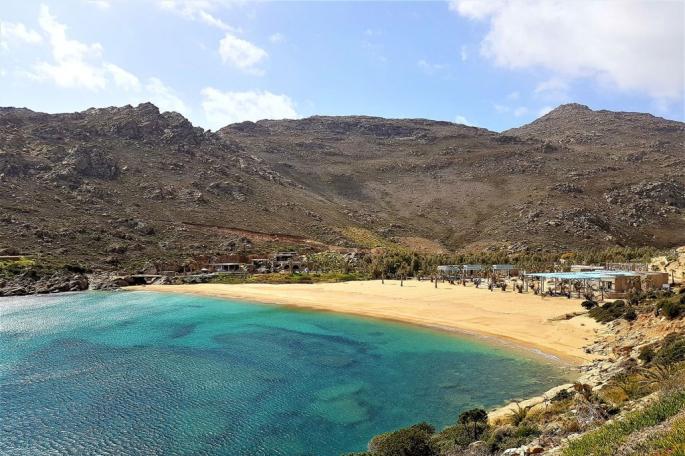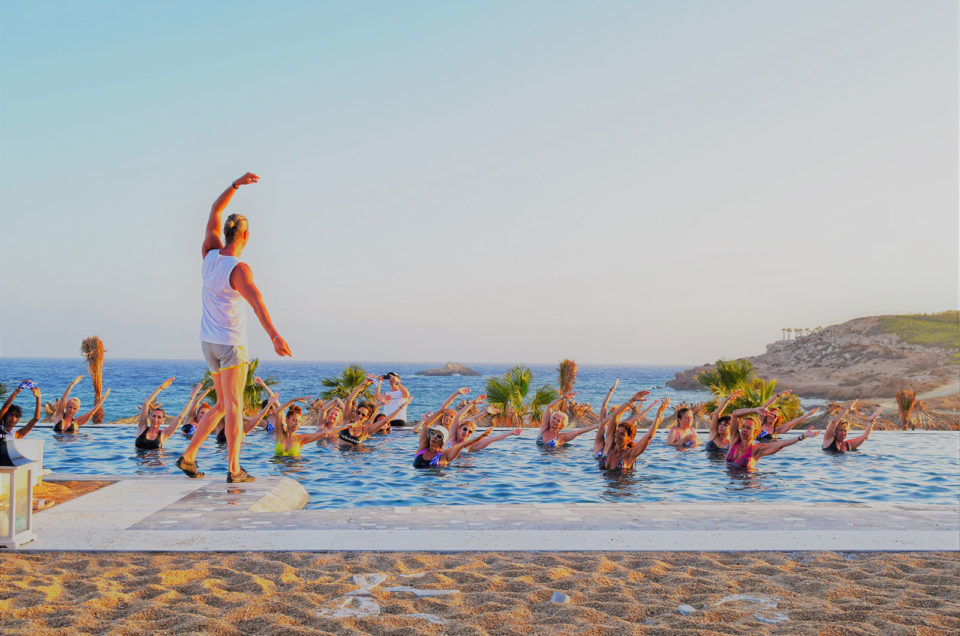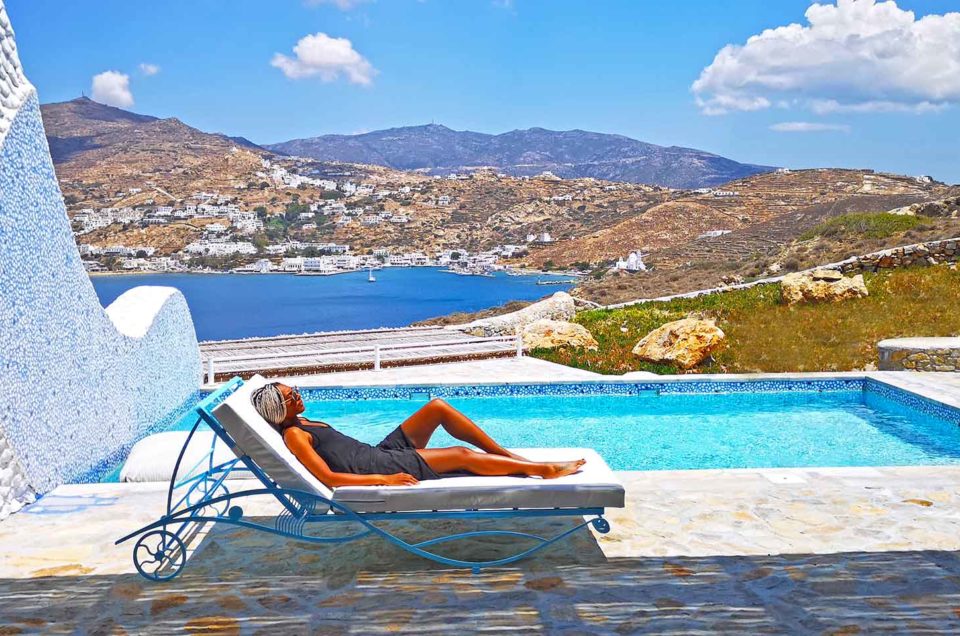LUXURY
Ios, the Greek island that’s gone from party town to luxury resort
Designer hotels, empty beaches and a burgeoning food scene await on the Greek isle of Ios
Amanda Dardanis, August 17 2019, 12:01am, The Times

Calilo has outdoor sanctuaries with private pools
Goats. They are all around us and just keep coming. Their bells are the first sound for miles on this uninhabited stretch of mountain road taking us to Manganari, a trio of southern beaches where they shot scenes for that cult classic for divers, The Big Blue. One minute we’re “wow-ing” over the throat-catching bay views at each twist of the road, the next we’re marooned, waiting for the straggly flock to be led to pasture by a young shepherd in Levi’s.
From our place among the goats, we are high enough and close enough to eyeball the famous clifftop villages of Santorini. They are an hour away by ferry, but encounters such as this are a thing of the past over on the world’s most photographed volcanic island. You’re far more likely to get stalled by tourists choking the arteries of Oia to catch the sunset (Santorini gets 3.6 million visitors a year to Ios’s 300,000).
My Greek-Australian husband first visited Ios half his lifetime ago, when he was in his twenties. The stories he brought back were enough to put me off for ever: downing his body weight in peach schnapps every night at watering holes with names like the Fun Pub; blurred days at spring-break-style beach parties with standing-room-only swimming pools. Ios was the Greek starter island where you haggled over your room rate in drachmas fresh off the ferry before treading the sin triangle between the port, expat-run bars in the hilltop capital of Chora, and the boom-boom beach club scene of Mylopotas.

The Calilo resort on Papas beach
Earlier still, in the 1970s, the island was a magnet for hippies who slept on rooftops, put up by easy-going locals who would give them a free breakfast before sending them on their way. While other islands have matured and evolved, Ios seemed destined to remain the Daytona Beach of Greece, the eternal adolescent parked between scene-stealing Mykonos and Santorini.
But change is coming to this island of goat-herders and cheesemakers. The party has simmered down and a new parallel narrative is emerging: one of beaches without crowds, newly found gourmet confidence and gentle, slow-burning beauty that chimes with the island’s other claim to fame as the final resting place of the father of western literature — Homer. At the same time, new luxury hotels, targeting a more sophisticated visitor, are reshaping Ios’s craggy contours. It’s the prospect of experiencing this Ios that has persuaded me to brave a visit during the peak summer season.
Leading the rebranding is the Greek-American hedge-fund whizz and artist Angelos Michalopoulos and his Athenian wife, Vasso Petridou, who run various Ios hotspots under their LuxurIos portfolio. So far, they have snapped up about a third of this modestly sized Cycladic island: 6,000 acres cobbled together from 2,137 plots (“we chased landowners down from Chicago to Melbourne”), with a promise to conserve all but 1 per cent of it as nature intended. Billed as the largest private coastal conservation project in the Mediterranean, the headline act of that “1 per cent” is Calilo, a 1,000-acre five-star resort with just 30 suites on Ios’s untapped eastern flanks. The ambitious “ultimate luxury” development on a 900ft private bay with six miles of coastal trails has been the talk of the island.
We set out from Ios port to digest Calilo for ourselves, blasting our way round the windswept southern coastline in their family speedboat, past Klima, Pikri Nero, and up to Papas, to make a Bond-worthy entrance at the recently opened resort. We spin out the trip first, though. When a beach takes our fancy we jump overboard and swim ashore, planting ourselves on coves curved like croissants under cloudless skies. There’s no one but the four of us. We’re living the Greek island dream.

We pass isolated holiday cottages and whitewashed chapels that stand out like squeezes of toothpaste against the stern rocky terrain. A skinny-dipping senior (and why not) pulls herself nimbly up a rope ladder at one deserted swimming spot. At our favourite beach, Tripiti, there’s a stone staircase carved into the rocks leading to a tiered sunbathing deck with a palm-thatched canopy. The view from there is bonkers, pure CGI. Anyone with the means to a boat can stake out a patch of this paradise, but Calilo guests can shoot over with a butler, picnic lunch and DJ to be posh castaways for a day.
We count half a dozen people-free beaches — and that’s just one leg of the island. It’s what kick-started Michalopoulos on his quest to save Ios from mass development and becoming “yet another ex-beautiful island like Mykonos or Santorini”.
“When I first sailed around the coast of Ios, in 2003, I found 15 completely empty beaches, in the middle of August,” Michalopoulos, who was born in Athens and is a Cornell graduate, says when we meet for breakfast the next day. “I couldn’t figure it out. I thought either the sun was too hot and I wasn’t seeing properly, or someone was carrying out secret nuclear tests here.”
Calilo is intentionally low-key. Hewn from marble and granite quarried on site, and framed by 55,000 new trees, the resort appears almost in camouflage when one arrives by sea. Bisecting the long, fine pebbled beach are thatched cabanas with enormous mattresses suspended above the sand by cables. Collapse on them after your swim and the briny sea breezes gently rock you dry.

Calilo is located on a private bay with six miles of coastal trails
Having overnighted at the couple’s other luxury hotel, Agalia — an artistic reboot of a traditional Cycladic taverna above the port — we had acclimatised to the touchy-feely design ethos (Agalia means hug in Greek). If Jeff Koons and Salvador Dalí got together and opened a hotel during the Age of Aquarius, it might look something like Calilo. Michalopoulos’s calling cards are intricate stone and tile mosaics, surrealist sculptures and a liberal sprinkling of love-is-all-you-need leitmotifs like painted butterflies. Then there’s what Petridou calls Michalopoulos’s “little men” — small digitally-designed silhouettes of figures in perpetual motion, cut into any available surface like a recurring self-portrait.
The centrepiece at Calilo is a vast saltwater lagoon pool with a sandy bottom to mimic the sea. It fans out, enveloping submerged loungers built into recesses, salvaged olive trees impaled on pillars, more of the cradle-like swinging mattresses and dining pods covered in bright mosaic where you can eat surrounded by water. “They look like little blue boats in a canal,” my youngest says, delighted.
Our suite alone has 72,000 tiles (we have two adjoining doubles overlooking the pool, sealed off in a long mosaic-lined corridor to create a private family annexe). Our headboards double as illuminated art installations at night, while the remote-controlled blinds have digital blow-ups of the Ios coastline to wake to. Other rooms have their own free-flow pools in discreet walled courtyards. Next summer there will be suites with pools embedded in elevated caves with mini waterfalls. But it’s the bathrooms that are the most exclamatory: floor-to-ceiling black and white marble set pieces with a sunken bathtub on steroids. “I feel as if I’m in Scarface,” my husband says proudly.
All that mobster marble amid the ungroomed scrub of eucalyptus and figs outside our window is an odd juxtaposition. No matter, the main Calilo philosophy, Michalopoulos says, is to coax guests outside to break the limiting holiday orbit of room to sunlounger. To drive the point home, he walks us through his “pride and joy” watermelon patch and up to the rocky hills above. The mountains are full of caves and they’re being linked by marked coastal trails so guests can hike between them. There’s also a 150-seat amphitheatre, built to stage cultural performances 170ft above the limpid bay.
“What we’re offering here is tremendous privacy. It’s just you and the sea,” Michalopoulos says. “Privacy is the 21st century’s most luxurious commodity.” The New Age thing is a bit of a red herring. In person, Michalopoulos is urbane, whip-smart and hugely charismatic. We take his advice and get out to explore Ios. No powerboat this time — we drive to Agios Theodoti, a sand and pebble beach on the northeast coast with glassy waters and reed-spliced dunes. Easily accessible by car, it’s a perfect all-rounder. You’re encircled by nature, but there’s a scattering of umbrellas and loungers at each end and a kiosk to make life more comfortable.
For nostalgia’s sake we drop in afterwards to party central, Mylopotas Beach (“look, girls, that’s where Daddy once bungee-jumped into the pool”) for a late lunch at Drakos, a popular over-the-water taverna at a polite remove from the main bar strip. We watch windsurfers chase the northerly meltemi breeze that frequents this deep-set cove, over minty meatballs and oven-baked squid stuffed with the local tangy soft white cheese (xinotiri).
No Greek island sortie is complete without snapping a cinematic sunset, cocktail in hand. On Ios that means making your way to Ios Club in Chora (the closest you will get to a Santorini-style aesthetic), or Pathos, a jaw-dropping, multi-layered juggernaut in Koumbara where we watch as a mostly young crowd queue for sunset selfies in the “shower ball”, a giant hollowed-out sphere with coloured massage jets suspended high above the sea. There’s a more muted, family-friendly version of Pathos on the beach below called Eregos, where we knock back some excellent summery bites such as octopus and fava tacos, and watermelon tapioca.

You’ll want to spend one evening up in Chora. There are prettier hilltop hamlets across the Cyclades — Folegandros, Kimolos, Serifos for starters — but they don’t have Katogi. At this quirky locals’ favourite, nestled inside a bohemian trio of 1830s cottages, you can tap Ios’s more eclectic gourmet pulse. Run by a hip local couple, Theodora and George, Katogi turns out creative Greek tapas to a packed house most nights (book ahead). We sit in a softly lit courtyard with a native passion-fruit tree and share cured water-buffalo mini burgers from northern Greece, and the Katogi house specialty of fresh pasta filled with pear and smoked local cheese. “Sometimes it’s crazy out there,” Theodora says, gesturing to the cobbled lane where Ios’s Saturday night is starting to percolate, “but in here it’s like a secret world.”
Give yourself a midnight curfew if you want to avoid the Chora hijinks, but try to factor in a nightcap at Kafeneio. A magnetic café in a doll’s-house square, it’s where locals gather beneath bougainvillea blooms to listen to live Greek music and drink ouzo (look for the colourful painted chairs). You can side-step the “souvlaki and crepe crowd” at Ios’s other fêted restaurant, Grandma’s, a cosmopolitan hotspot with views over the port and Sikinos island. It’s at Liostasi, a drop-dead gorgeous luxury bolt hole just outside Chora (the hotel’s fresh take on Cycladic glamour translates into edgy leopard-print loungers, a clubby open-plan lobby saturated with contemporary Greek art, and a private suite with a showstopper glass pool).
But the standout meal of our visit (and possibly the best food I’ve eaten all year) is at a newcomer, Ithaka. This unassuming eatery on the outskirts of the port is ground zero for the island’s up-and-coming foodie scene and is likely to change what you think you know about Greek cuisine. The food is confident, heartfelt and reasonably priced: think dismantled spanakopita salad with grated goat’s cheese and Ios honey; and sea bass ceviche with fennel and olive oil from the chef’s olive farm outside Athens.
Too soon, it’s time to leave. We’ve barely dented the 30-odd beaches or ticked off archaeological drawcards such as Skarkos Hill, an early Bronze Age settlement excavated late last century with well-preserved evidence of people living in two-storey villages, around the time the pyramids were built. But it’s Homer’s tomb on the northernmost tip that cements my new ardour for this lovely isle. Ios isn’t the only Greek island to lay claim to the epic poet’s remains. They make a pretty good case, though (a 17th-century archaeologist allegedly unearthed an ancient tomb inscription bearing Homer’s name here and texts from Herodotus support it).
Again we find near-empty roads and a revelatory landscape on the 20-minute drive from the port: olive groves and vineyards, lavender and thyme, honey farms and crumbly stone shepherds’ shacks garnish an echoing backcountry that has the high drama of the Arizona desert. “It feels like we’ve got our own private island to explore,” my 13-year-old says, accustomed to the hurly-burly of Athens.
Apocryphal or not, the location rings with poetry. Circling the marble and stone monument is a citadel of cairn memorial pillars that visitors before us have helped to build. To the soundtrack of cicadas and Homer’s “wine dark ocean” crashing on to the rocks far below, we scout for our own flat stones and add four more. Down in the port they’re flogging “I’m in Ios, Baby” T-shirts, but on this elemental promontory it’s our way of saying: “I was here.”
Need to know
Amanda Dardanis was a guest of Agalia Luxury Suites and Calilo Beach Heaven. Rooms at Agalia range from €100 to €1,200 a night, and at Calilo from €250 (for a garden view suite) to €1,600 (for a seafront suite with private pool and waterfall). Golden Star Ferries runs daily services to Ios from Piraeus, Athens, on a Supercat (6 hours 40 minutes), or Seajets runs its Tera Jet (about four hours). Alternatively, fly direct from London to Santorini and take a one-hour ferry to Ios.
Original Source: https://www.thetimes.co.uk/edition/travel/ios-greek-island-that-s-gone-from-party-town-to-luxury-resort-lmqdhw8cf




